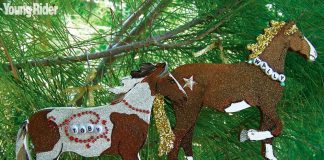Holiday season is here! That means the trees are losing their leaves and snow is getting ready to fall. If you live in an area that gets chilly, get ready to bundle up!
Check out our winter care tips to make sure your horse stays as comfortable as possible during the winter months.
To Clip or Not to Clip
When cold weather comes, you have two choices. You can clip your horse, or you can let his winter coat grow in.
If you don’t clip your horse during the winter months, you need to groom him regularly. A horse’s coat will fluff up in the winter to retain heat, so make sure to remove mud and dirt from his coat.
However, if you plan to exercise your horse a lot during the winter months, you might consider clipping your horse. Clipping him can make grooming easier and decrease cool-out time. Even though it’s cold outside, your horse will still sweat, meaning his coat will be wet after you ride. If you leave him out and he’s wet, he could get chilled and he might get sick. A clipped horse will dry much faster.
There are different types of clips, including a full body clip, a hunter clip and a trace clip. Talk to your instructor or veterinarian about the best hair cut for your horse or pony, and make sure your clippers are working well.
Cozy Blankets
If you do clip your horse, you need to blanket him. You wouldn’t want to go outside without a jacket. A horse without his thick winter coat wouldn’t want to either!
Remember, a horse should be clean and dry before you put a blanket on his back.
There are tons of different styles of blankets, and you want to make sure a blanket fits your horse properly.
You should be able to run your hand along the blanket’s entire neck opening. You don’t want the blanket to be too tight and cause rub marks or sore spots. It should cover your horse’s tail, and it shouldn’t shift much when your horse moves.
If your horse lives in a climate that warms up during the day, consider only blanketing your horse at night. You don’t want him to be sweaty underneath the blanket.
Lots of Water
Even though the temperature drops in the winter, your horse still needs lots of water. To stay hydrated, horses need anywhere from four to 20 gallons of water a day!
However, water troughs may freeze in cold climates, especially overnight, so it is important to check your horse’s water supply several times a day. If the trough freezes, break the ice and remove it from the trough. A horse can’t break the ice himself, and he’ll be much healthier drinking water than licking snow!
Feeding
One way to help your horse stay warm is to make sure he gets a lot of fiber. Hay is higher in fiber than grain, so feed your horse more hay during the winter months. When your horse’s large intestine digests the hay, his body creates energy, warming him from the inside out.
As always, talk to your veterinarian before making any drastic changes in your horse’s diet. All diet changes should be done gradually so you don’t upset your horse’s delicate digestive system.
Stabling
If your horse lives in a stall, make sure he’s cozy in his winter home.
Check that his stall has comfortable flooring and bedding. Rubber mats drain well and are durable. There are countless options for stall bedding, including shavings, wood pellets and various types of straw. Regardless of what bedding you use, make sure you use enough to keep your horse warm when he lies down. Also, make sure your horse’s stall has plenty of ventilation.
Skin Conditions
The harsh winter elements can sometimes irritate your horse’s skin. While grooming and blanketing can help eliminate some of the risk of these skin conditions, they may pop up anyway.
Rain rot can happen when your horse is exposed to rain or snow and his coat remains wet for an extended period of time. It causes scabs to form on a horse’s neck, shoulders, back and rump. The scabs can make a horse very uncomfortable, and they can even keep the horse from being ridden.
The best way to treat rain rot is to keep the areas very dry and clean. Rain rot is contagious, so make sure to use different grooming tools on a horse with the condition and bathe him with medicated shampoo. Let him dry completely before you blanket him or turn him out.
Mud fever is essentially rain rot on the horse’s legs. The best way to prevent mud fever is to keep your horse’s legs as clean and dry as possible. If your horse has feathers, you’ll want to be even more diligent about cleaning and drying the hair around his legs.
Winter Shoeing
Winter brings snow and ice–two things that don’t work well with horseshoes. If you don’t plan to ride your horse much during the cold months, consider pulling his shoes.
If you plan to do several trail rides in the snow over the winter months, consider getting snowshoes for your horse. Riding in the snow can cause ice and snow to get stuck in your horse’s hooves, and packed hooves can be extremely uncomfortable for your horse.
A snowshoe is a metal shoe with a rubber, bubble-like circle pad placed in between the hoof and the shoe. Snowshoes help pop frozen snow and ice out of your horse’s hooves.
Talk to your farrier about the best winter hoof care for your horse.





